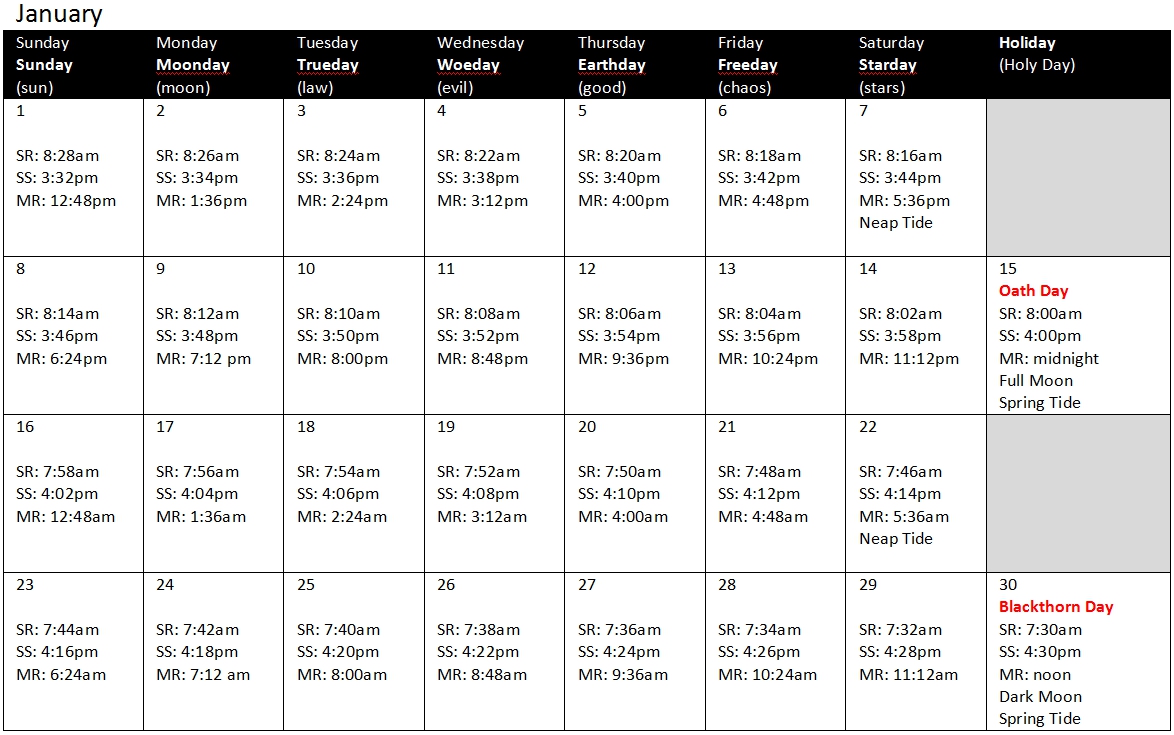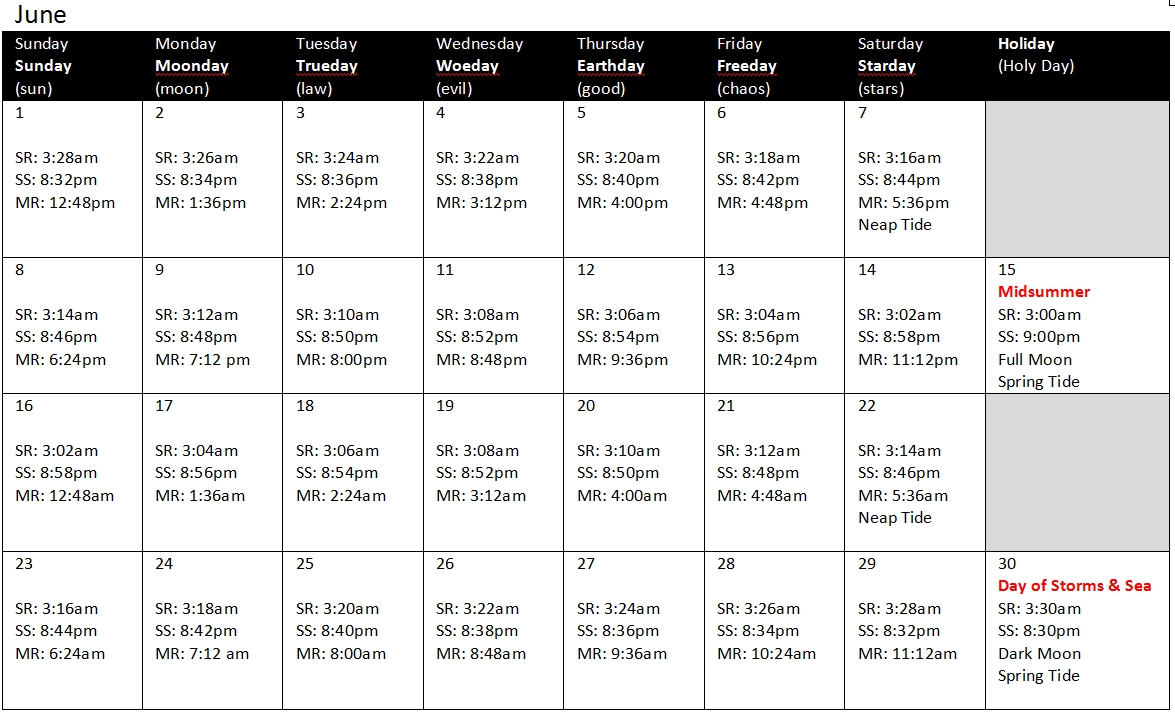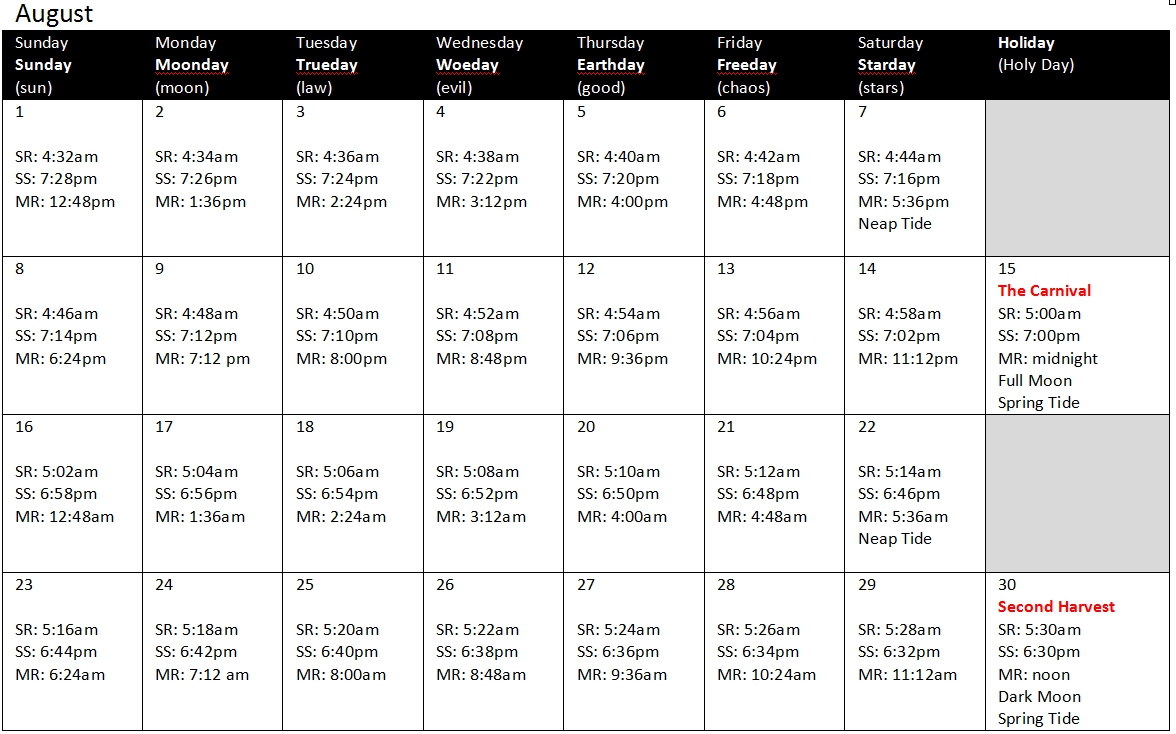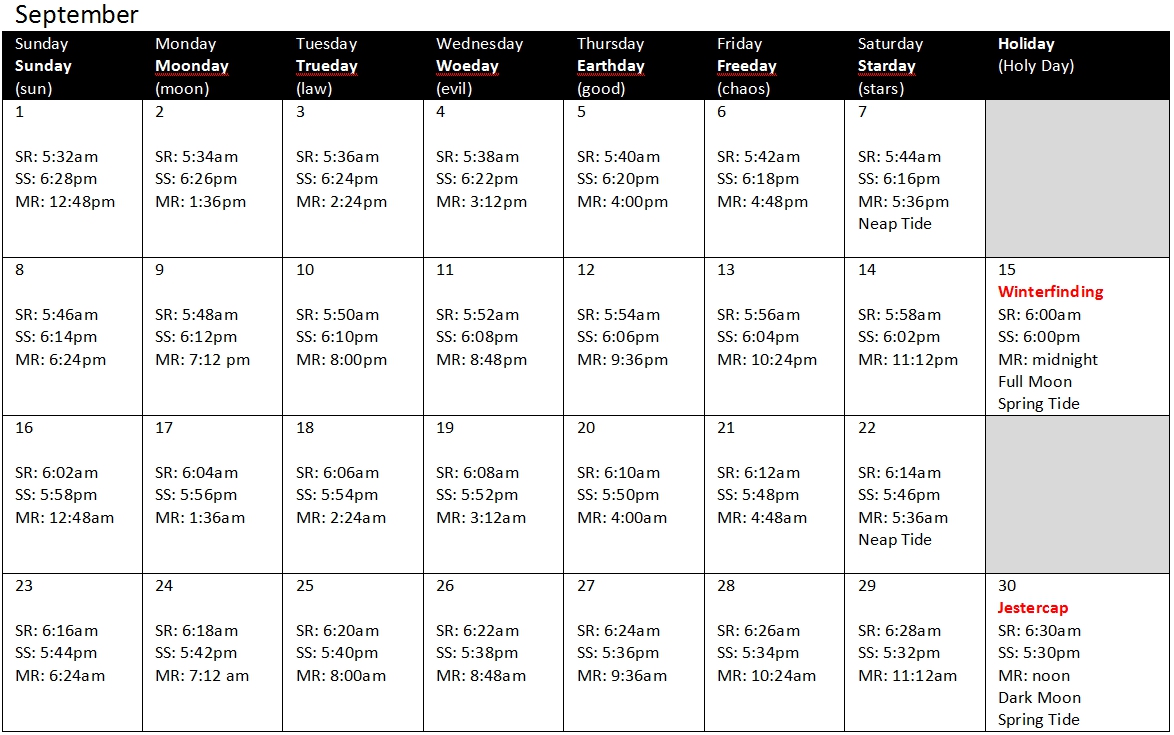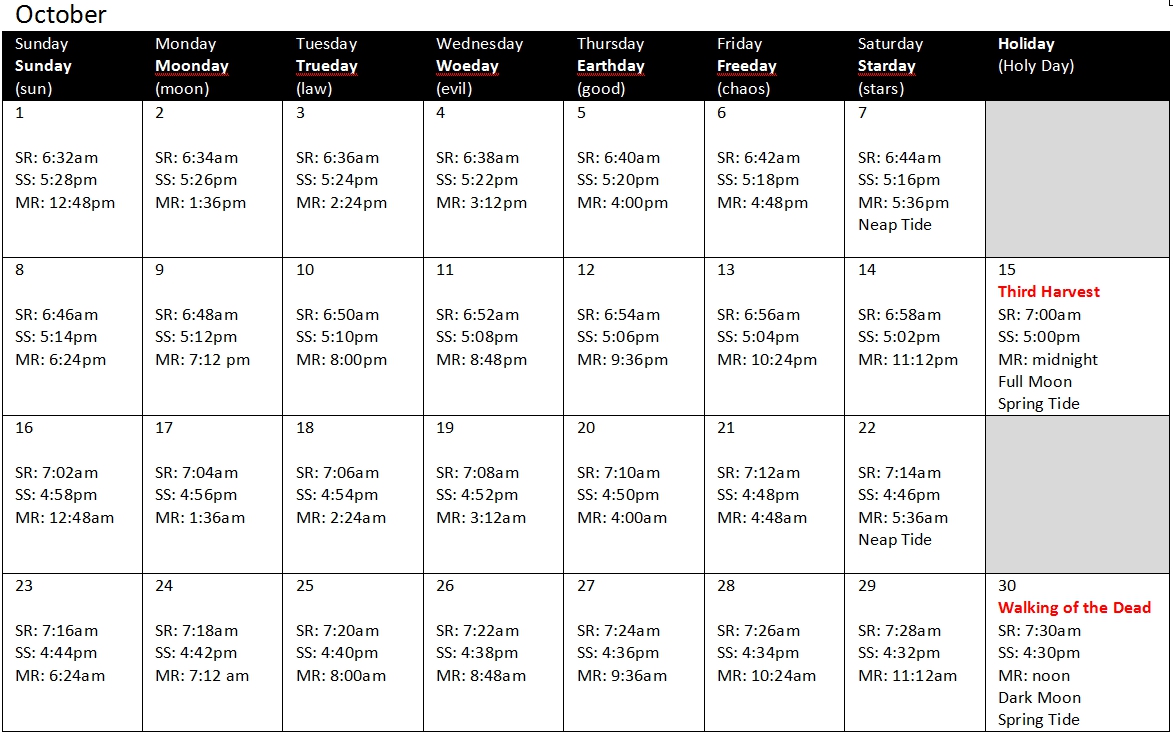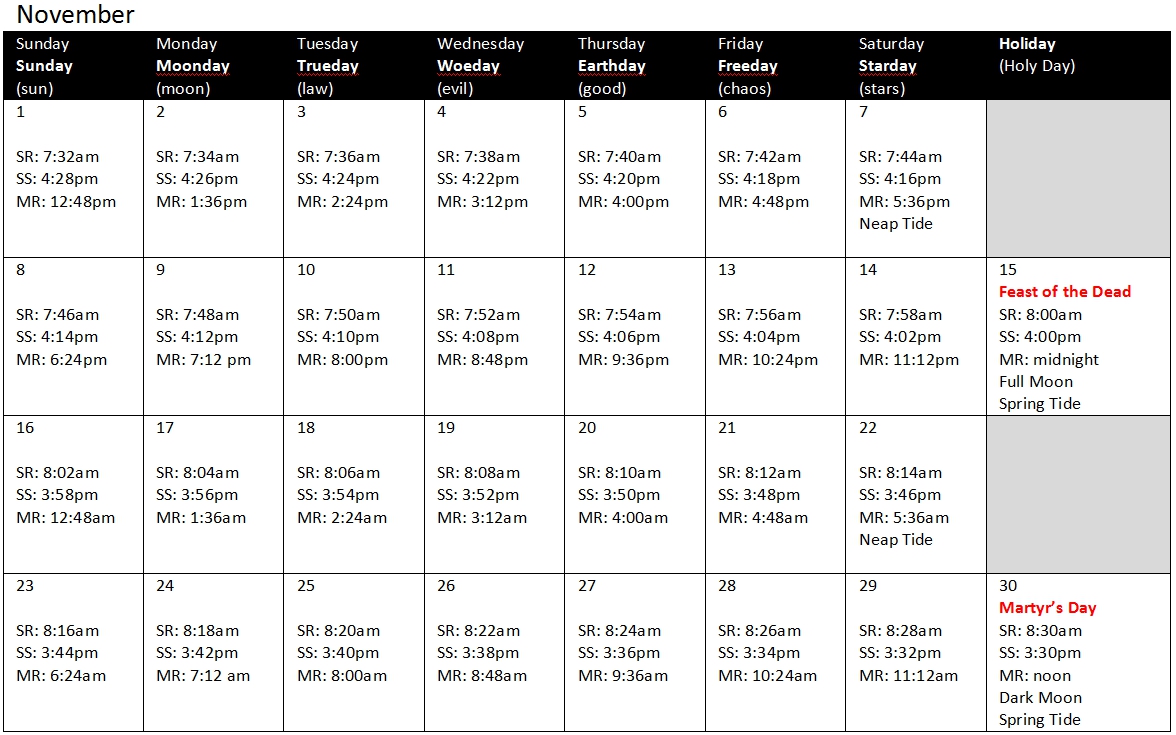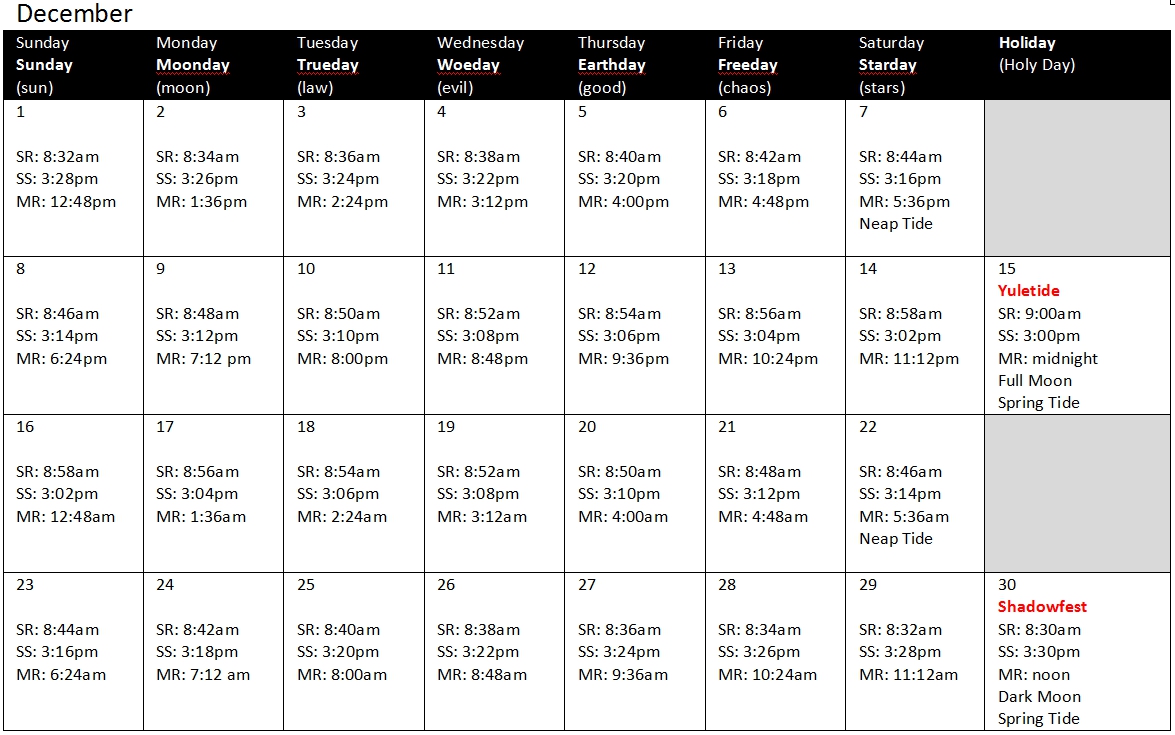Calendar
The current calendar was adopted in the early First Age by the Church of the Hearth, the festivals and holy days being passed down with few modifications over the centuries. The origin of most of these celebrations is rooted in agrarian life and the natural world, following the yearly cycles of birth and death. Many other religions have celebrations and rituals that mirror the holy days of the Church of the Hearth, although this is the common calendar used throughout the Realm.
Month names honor the first twelve patriarchs of the Church of the Hearth, and day names honor the heavens (sun, moon, and stars) and the different alignments found in the Realm (good, evil, law, and chaos). Sunrise (SR), sunset (SS), and moonrise (MR) are for the latitude of Teufeldorf and Dragonsford (e.g., 45 degrees north). Calculations for other locations as well as the tides can be found here.
Oath Day (1/15) is the traditional day when journeymen and apprentices renew their pledges to their guild. In many towns, this is also the day when new recruits are accepted into a trade and guild masters are named. During the day, many shops will be open with their stock from the previous year available at discounted prices. During the evening, secret and public guild meetings welcome new members and promote master craftsmen.
Blackthorn Day (1/30) is a hearth fire festival that begins at sundown with bonfires and candle lighting ceremonies to harken the return of warmth and sunshine. Homes are decorated with blackthorn which blooms at this time. Traditional feasts are marked by participants making speeches and reciting poems to honor the gods and the monarchy. A sacrifice for peace and prosperity in the new year concludes the celebration at daybreak.
Heartwood Day (2/15) begins with young men carving small trinkets from the heartwood of chestnut, hawthorn, silver maple, or black willow trees. Oftentimes, these trinkets will be heart-shaped. During the day, these are given to the young women they love - with some giving and receiving multiple trinkets. In the evening, all the women of the town gather privately to have a meal and discuss the offers. Unrequited tokens are burned in the hearth fire. Accepted tokens display public affirmation of a couple's love.
Shepherd's Day (2/30) is a feast dedicated to spring birth and the success of the flocks and herds for the upcoming year. It is said to have originated from the ewe's lactating prior to the first birthing of the spring lambs. The celebration is typically held in the town hall with a feast open to all. It is common for the sacrifice of a wolf or other predator to be made after the meal.
Summerfinding (3/15) is a holiday of balance, as day and night are of equal length with the sun rising and setting due east and west respectively. Both sunrise and sunset are times when the townsfolk gather on a clear hill to watch the phenomenon. Oftentimes, stones are arranged to mark this celestial event. The most common celebration is an elaborate mock battle at noon where elders dressed as Summer fight others dressed as Winter. Summer slays Winter to the cheers of the crowd, and a feast celebrating summerfinding - usually featuring wild hares - is enjoyed.
Wicker Man Night (3/30) has its origins in the dark practices of magic. According to tradition, a large man-shaped effigy called the Wicker Man would be built of sticks. Into this creation, evil men and women would be placed - usually criminals - and the Wicker Man would be set alight at midnight. This was done to frighten the evil spirits causing them to flee the town. Banned in the early Third Age, the tradition now involves a small Wicker Man in which the townsfolk place scraps of paper with their evil thoughts written on them. Burning the Wicker Man is said to chase those thoughts away. Rumors persist that secret practices still follow the old ways.
Waking the Forest (4/15) begins at dawn with the townsfolk gathering at the edge of the largest or most sacred forest in the area. Celebrants dress in bright green and brown clothing, often costumed as hunters or woodsmen. As the sun rises, a processional through the forest begins with soft humming and prayers to the forest creatures, most notably the fey who are thought to awake from their mounds on this day. The celebration gets louder to slowly wake the forest culminating in a huge picnic feast in a large clearing served by elders dressed as the Green Man. Food and drink are left behind as offerings for the fey in appreciation for the bounties that nature will bring during the year.
Festival of Flowers (4/30) is the mid-spring festival which is marked by a day of outdoor festivals and markets. Water wells are blessed at daybreak. Most celebrations focus on flowers with primrose, rowan, hawthorn, and marsh marigolds placed in doorways and windows. Each town decorates a thorn bush with flowers, ribbons, and bright shells. A traditional dance around the fairy tree - a pole that is wrapped with flowers is common. Bonfires are lit in the evening and the ashes from these fires provide protection from evil and chaos.
Lemuria (5/15) is the night that families perform a ritual to drive malevolent ghosts of the dead from their homes. Known as lemures, the custom is to expel these evil spirits by having the head of the household walk around the house at midnight in bare feet chanting, "ghosts of my fathers and ancestors, be gone" while the rest of the family clashes pots making noise to frighten the spirits. Prior to the rite, families feast on a salted flour cake made from the first ears of wheat of the season.
Novice's Day (5/30) is traditionally the day that young men and women are chosen to join the ranks of the Church of the Hearth. In the weeks preceding the holiday, clerics journey throughout the land looking for children with the talent and skills to become novices. The lucky few are announced at a large feast in the town hall. In time, this practice has been extended to other magical practices, similar to the current practice of Oath Day for crafts and trade.
Midsummer (6/15) celebrates the longest day of the year. Midsummer's Eve is marked with bonfires made of oak and sprinkled with aromatic herbs. Celebrants dance around the fire and tell stories until daybreak in hopes of protecting the town from evil spirits as the sun turns southward. During the day, feasts are held in town squares and the largest oak tree in the area is decorated with ribbons and bright baubles. There are contests for baking and drinking, and merriment is paramount. At sunset, in some towns, the Oak King brings children gifts and toys at the decorated tree.
Day of Storms & Sea (6/30) celebrates the calmest seas of the year and the bounty of fish that provide food for many coastal towns. The celebration begins at dusk when a boat loaded with brush and wood is lit afire and set adrift. The townsfolk sing to the departing boat for good fortune, and sailors are honored at the feast that follows. Away from the coasts, the day celebrates the summer storms which peak during this time of year with dramatic storm fronts, lightning shows and torrential downpours. A bonfire replaces the boat in the celebration, although fish is still served and fishermen, if any, are honored.
Dragonsfire Festival (7/15) begins with the preparation of a huge pile of wood and rubbish - designed to produce plumes of black smoke. Lit at noon, the smoke is meant to drive away the dragons that hunt the summer herds of local farmers. As the fire burns into the night, the festival turns to a celebration with dragon-cakes, dancing, music, and - most importantly - fireworks in towns that are lucky enough to have a wizard in residence.
First Harvest (7/30) is a mid-summer festival to celebrate the harvesting of grain, typically the first cutting of the corn for the harvest season. Many towns bake elaborate bread sculptures which are eaten at a town fair. It is common for these gatherings to feature athletic events when the region is not at war. A bonfire on the highest clear hill is usually lit at dusk with dancing and music extending into the night.
The Carnival (8/15) is a celebration of the peace between humans and the other races - most notably the elves, dwarves, gnomes and hobbits. The day is filled with feasts, music, dancing, and most importantly contests - with each race bringing their own challenge to the event. It is also a time when different racial food and drink are shared. The festival climaxes with the Carnival - a masquerade dance with magical trinkets used to disguise dancer's features such as race and gender. At midnight, the participants remove their disguises to their partners, often with unpredictable and delightfully awkward results.
Second Harvest (8/30) is sometimes called the Green Man's Feast. It celebrates the harvest of fruits with offerings of ciders, wines, apples and grapes. The festival is marked by a town feast where guests are encouraged to wear their finest clothes and decorate lavishly. Marking the transition to autumn and winter, focus turns to finishing old business and preparing for the hard months ahead. Many towns will have a Green Man tree in the forest usually with a carved face and hands where offerings are left during the festival for continued prosperity.
Winterfinding (9/15) is the contrasting holiday of balance to Summerfinding. Again the townsfolk gather on clear hills to watch the sunrise and sunset due east and west. Again, a mock battle at noon is undertaken but this time the dark-dressed Winter combatants slay their white-dressed Summer counterparts. The mood, while celebratory, is more somber - recognizing that the darkness of winter approaches. The feast typically features wild deer which are a staple of most winter tables.
Jestercap (9/30) is a night of revelry and comedic entertainment. In contrast to the somber Winterfinding, this holiday is a time when anyone can pull pranks, jokes or japes on companions, neighbors, and (more typically) rivals, with the understanding that providing no lasting harm is done, any humiliations inflicted before midnight are to be taken in stride. Of course, come the next morning, there are inevitably jokes that went too far, and grudges and feuds borne from Jestercap antics have a way of lingering for months to follow.
Third Harvest (10/15) is a feast celebrating the end of the harvest season. Root vegetables, gourds and squashes are in abundance, and the winter slaughter of the livestock is undertaken. Bonfires are lit to insure that the villagers and livestock survive the winter. In appreciation for the bounties of nature, offerings of food and drink are oftentimes left outside for the fey who many believe are preparing to leave the woods and return to their mounds for winter.
Walking of the Dead (10/30) begins a four-week period during which it is said that the recently-departed are allowed to roam the Realm and wrap up their worldly affairs before returning to the afterlife. A dawn service on the first day honors those who have died with prayers to have their spirits move on during the upcoming weeks. During the day, families go to cemeteries to leave flowers and speak with the recently departed. Feasts during this time often have a place set at the table for the dead. Bonfires and revelry are common at night.
Feast of the Dead (11/15) is height of the period where the veil between this world and the next is at its thinnest. It is believed that those who are able to pass on to the land of the dead have done so, with those unfortunates left behind languishing another year in tormented oblivion. In order to protect themselves from being recognized by restless spirits, townsfolk don costumes and masks and prepare great bonfires and harvest feasts to see them through the night.
Martyr's Day (11/30) is the culmination of the four-week celebration of the dead. This feast honors those who have died in battle or in noble service over the years - ancestors, family, elders, friends, and loved ones. Feasts are held in homes, rather than public spaces. Most towns follow the practice of 'souling' in which bands of children go round to houses after the feast begging for apples, soul-cakes and other sweets. The children chant rhymes as they go door-to-door in order that the souls of the dead might find comfort.
Yuletide (12/15) is the mid-winter feast on the shortest day of the year, a celebration of hope against the darkness. As such, the feast includes the burning of the yule log taken by cutting a massive tree which is then shared by all the townsfolk and the cooking of wild boars - again, an undertaking shared by the town. Hunters and woodsmen are honored at these feasts. Homes are decorated in wreaths of evergreenery - holly, ivy, mistletoe, yew and pine. In some towns, the Holly King brings children gifts and toys.
Shadowfest (12/30) is also known as the Day Between Years. Feasts at home are focused on the blessing of the household in the early evening. At midnight, it is traditional to visit the homes of friends and neighbors, with special attention given to the first-foot, the first guest of the new year who brings a gift of silver, bread, salt, coal, evergreen and whisky. These are to bring prosperity, food, flavor, warmth, long life and good cheer respectively. Others gift exchanges are common. Some arcanists believe that the stroke of midnight allows movement between different times - a step between years.
Astronomical Calculations
This calendar is for 45 degrees N latitude (i.e, Teufeldorf and Dragonsford). All times are local.
- SR = Sunrise; SS = Sunset; Other SR an SS times can be extrapolated.
- At the equator, SR is always 6:00am and SS is always 6:00pm.
- At the north pole, 12/15 is always dark and 6/15 is always light.
- MR = Moon Rise; Tides can likewise be extrapolated.
- There are two high tides each day. High Tides are MR +6hr and MR -6hr.
- Moon Set is MR +12hr.
- Neap Tides are the lowest high tides and highest low tides.
- Spring Tides are the highest high tides and the lowest low tides.
